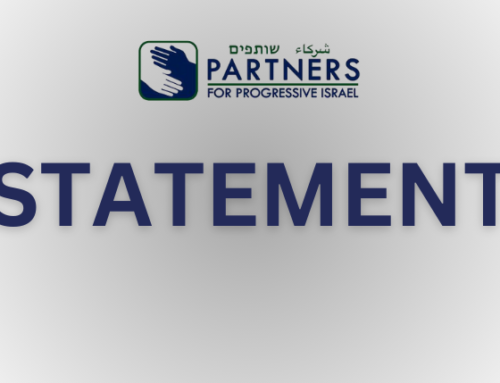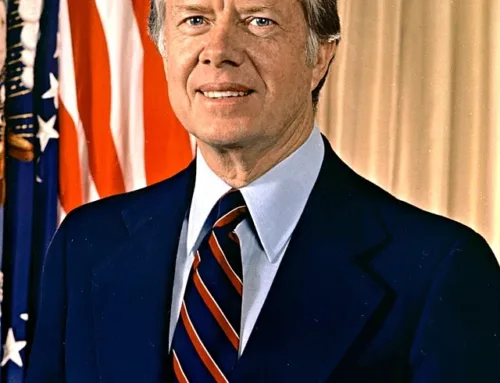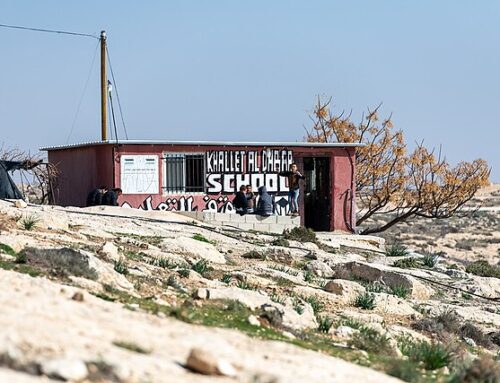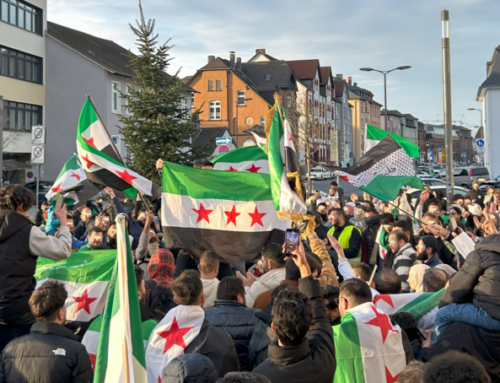Tom Segev of Haaretz reminds us of one of the most horrible events of Israeli history. The massacre at Kafr Kasem, at the outset of the 1956 Sinai war, perpetrated against unarmed Israeli Arabs who innocently violated a curfew order that they were not aware of, is a sad and outrageous historical fact that is beyond dispute. — R. Seliger
‘If the eye is not blind nor the heart closed’ By Tom Segev / Haaretz / Oct 29, 2006
Latif Dori came to Kafr Qasem this week and could barely make it down the street. The 72-year-old peace activist is considered a local hero. Whenever he comes here, passersby recognize him and want to stop him and shake his hand warmly. Passing drivers honk their horns and wave. The local council bestowed honorary citizenship upon him. He is part of the history of this village, and of the state: In 1956, Dori was the first one to record the horror stories told by survivors of the massacre perpetrated by Border Police troops.
Dori was then the secretary of the Arab Division of the United Workers Party (known by the Hebrew acronym Mapam, of which the only surviving trace is the mem [“m”] in Meretz). Someone from Kibbutz Hahorshim – Dori doesn’t know who it was – wrote to the Mapam leader Meir Ya’ari and told him about the massacre. It wasn’t the first time he had heard of soldiers behaving this way. Ya’ari didn’t like such letters, but this time he couldn’t ignore the information he had received because it was clear that something truly terrible had occurred. So he sent Dori to look into it.
It was the day after the massacre. Dori tried to enter Kafr Qasem but found it surrounded by soldiers and police officers. It wasn’t until the following day that he was able to reach the village mukhtar, who didn’t know much, but sent him to Beilinson Hospital in nearby Petah Tikva, where the wounded had been taken. There, among the wounded from the Sinai Campaign, Dori found the survivors of the massacre in Kafr Qasem. He took down their testimonies and had them sign them.
Prime Minister and Defense Minister David Ben-Gurion knew about the massacre by then and was horrified; he ordered an investigation, and later arrests and a trial. But he also tried to conceal the incident. The military censor prohibited its publication, and for several weeks the story was only spread by word of mouth. Communist MKs Tewfik Toubi and Meir Wilner mentioned the massacre in the Knesset plenum and their words were stricken from the protocol. Human rights and peace activists also spread word of the story. An initial, somewhat hazy item on it first appeared in Haaretz; the full story was first published in Uri Avnery’s weekly, Ha’olam Hazeh.
The testimonies collected by Dori eventually served as evidence at the trial. Dori has kept them until today. From the beginning of next week, they will be displayed at the memorial center to be inaugurated in the village, along with items of clothing and various objects that belonged to the victims, photographs, films and documents, including the protocols from the trial.
It happened on Monday, October 29, 1956, a little after 5 P.M. The Sinai Campaign began at about the same time. For several days, there had been talk that the Israel Defense Forces might stage an incursion into Jordan, apparently in order to disguise the true intent to invade Egypt. As part of the preparations, the army planned to evacuate the Arab villages in the “Triangle” area and transfer their residents to holding facilities in the center of the country.
The plan was given the code name “Mole.” The Border Police had thought of an alternative plan: to block passage from the Triangle villages to deeper inside the state, and expel their residents across the Jordan. Both plans were cancelled when it became evident that the war was going to take place in Sinai. But according to writer Rubik Rosenthal, who exposed this story many years later, the expulsion plans “remained in the air.”
A curfew was imposed on the villages of the Triangle; violators were to be shot on sight. Several dozen residents, including women and children, unaware of the curfew, were late in returning to Kafr Qasem. They came in groups, on foot, by truck or riding bicycles. Following their orders, Border Police troops stood them in rows and shot them to death, as they continued to arrive in group after group. The official count says that 47 people were killed that day; the monument erected in the village adds an old man who died of a heart attack upon hearing that his son was among the dead, and the unborn baby in the womb of his mother, who was killed.
Seven survivors of that day who still remember it live in Kafr Qasem today. Most of the village’s 18,000 inhabitants were born after the massacre, although it has nevertheless become a component of their identity. Ayoub Ali Taha was 2 years old at the time. He remembers exactly how he learned that his father was among those killed: by his grandmother’s condition. When she heard that her son had been shot to death, she went blind and became partially paralyzed; her grandson was sent to help care for her . The old woman blamed herself for her son’s death: “You father wanted us to move to Saudi Arabia,” she used to say over and over. “I didn’t want to leave Kafr Qasem. If only I’d agreed – then he wouldn’t have been killed.”
When Ayoub was 7 years old, older youths asked him to help hide the yearly memorial posters that were printed – in violation of orders from the military administration. He felt that he was participating in a heroic underground act in memory of his martyred father. Ayoub’s son Mohammed, an 11th-grader, is very familiar with the story; he links the massacre to the military administration to which Israeli Arabs were subject until 1966, and believes that with the Israeli democracy that exists now, it could never happen again. Sheikh Abdullah Nimr Darwish, however, says that the Kafr Qasem massacre is still going on.
Sheikh Abdullah Nimr Darwish offered us sweets in honor of the Id al-Fitr holiday. A founder of the Islamic Movement and a resident of Kafr Qasem, he is a warm and charismatic man, and one of the main spokespersons for the Arab public in Israel. That evening, he was following the news on television; the bloody events in Gaza had him in a bleak mood. He sees a direct line from the Deir Yassin massacre to the Kafr Qasem massacre to the events of Land Day, the October riots of 2000 and all that has happened from then until today, in Israel and the territories. The massacre in Kafr Qasem gave rise to a powerful slogan, said the sheikh: “Never Again.” He raised his voice and repeated the words in a rising crescendo: “Never again, never again.”
Suddenly he went silent: The slogan has collapsed, he said. Unfortunately, he estimates that 40 percent of Israelis do not support coexistence between Jews and Arabs or a peace-compromise. Meanwhile, the sheikh made a calculation and found that about 15 percent of the residents of Kafr Qasem are descendants of the massacre victims, and for that he is proud of his fellow villagers.
We argued a little about this. On second thought, Darwish agreed that the Kafr Qasem massacre was nonetheless an exceptional event. It spawned a few very powerful and enduring phrases, such as “black flag,” which came up during the ensuing trial – referring to a clearly illegal order and the moral imperative to reject it.
The trial was open to the public for the most part. It sparked a public discussion of basic questions of ethics and democracy. Since it happened 12 years after World War II, this discussion took place against the backdrop of the Holocaust. Judge Benjamin Halevy, who would later be one of the judges presiding over the trial of Adolf Eichmann, asked one of the defendants if he would also justify a Nazi soldier who obeyed an order. Sheikh Abdullah is appreciative of this.
Halevy felt that the order to kill residents of Kafr Qasem was “manifestly unlawful” and defined it thus: A black flag should fly over such an order, like a warning: “This is unlawfulness that pierces the eye and agitates the heart, if the eye is not blind nor the heart closed or corrupt.” This was a literary definition, not a legal one. It is not sufficient, but to this day no one has come up with a better one. Hence its importance.
The eight defendants, including an officer with the rank of major, Shmuel Malinki, were given prison sentences ranging from seven to 17 years. On appeal, the sentences were reduced, and not long afterward, the men were granted clemency. An officer with the rank of colonel, Issachar Shadmi, was acquitted on most of the charges and fined just 1 grush (1 cent in the old Israeli currency), for imposing a curfew without proper authority. Malinki went on to become the security officer for the atomic reactor, and later took over a gas station. First Lieutenant Gabriel Dahan, who was initially sentenced to 15 years, changed his name to Dagan and moved to Paris, where he worked as an Israel Bonds representative.
The Ministry of Education reported this week that “the Kafr Qasem events” are being taught now for the eighth year in a row in the framework of citizenship studies, as part of a mandatory chapter entitled “Obeying the Law in a Democracy and the Issue of a Manifestly Unlawful Order.” This isn’t enough, says writer Oula Issa; the whole story should be a part of the history curriculum.
Latif Dori suggested to the education minister that the massacre be the subject of one home-room hour. He received a five-line reply from a ministry adviser named Fadl Ibrahim: Unfortunately, Dori’s letter was not received far enough in advance; maybe next year. The ministry says that it will instruct school principals to make note of the anniversary. A spokeswoman at the Education Ministry quoted Minister Yuli Tamir: “The massacre and the subsequent trial became a foundation stone in Israeli society’s national consciousness and imprinted upon generations of commanders and soldiers in the Israel Defense Forces the moral boundary by which to act.” In other words, we’ve learned the lesson. How nice.
Actually, teacher, we haven’t learned it all that well. The story has been told again and again, in newspapers, books and movies, and an answer has also been found to the question of why the Border Police officers killed dozens of villagers: No, not only because they obeyed a manifestly unlawful order, but also because they hated Arabs. The IDF explains to many of its troops what a manifestly unlawful order is, and in the past 50 years Israel has not had another Kafr Qasem massacre. Who knows – it may have happened once in a while that someone remembered Kafr Qasem at the right moment and restrained himself. Council head Sami Issa believes that to this day there are government officials who, because of the massacre, display a special sensitivity toward his village; Border Police usually stay outside the village.
But not every soldier hears during the course of his service that there are orders that must not be carried out; the IDF does its best to wear down any conscientious objection; soldiers shoot at Palestinians as part of the routine of the occupation; police officers working in Arab communities in Israel sometimes have a light hand on the trigger; Avigdor Lieberman is in the government.
In Kafr Qasem, they feel that the state still needs to take moral responsibility for the massacre. Here is an opportunity for a historic gesture of decency and reconciliation, in the form of a statement by the president, the Knesset Speaker, or the prime minister. But no such statement has been forthcoming. Council head Issa isn’t surprised: “Israel missed out on the country’s Arabs,” he says. Up until a few years ago, the council used to invite government representatives to take part in the yearly memorial ceremony; usually, they didn’t come. This year, they were not invited.





I wsould like to relate an event in October, 1948 during the Independence war, a happening I consider an atrocity, the memory of which has never left me. Ia am afraid that it is too long a story -about 5 pages- for this blog.
Abbie Lipschutz